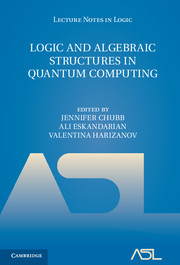Book contents
- Frontmatter
- Contents
- Preface
- Introduction
- 1 A (very) brief tour of quantum mechanics, computation, and category theory
- 2 Could logic be empirical? The Putnam-Kripke debate
- 3 The essence of quantum theory for computers
- 4 Fiber products of measures and quantum foundations
- 5 Operational theories and categorical quantum mechanics
- 6 Relating operator spaces via adjunctions
- 7 Topos-based logic for quantum systems and bi-Heyting algebras
- 8 The logic of quantum mechanics – Take II
- 9 Reasoning about meaning in natural language with compact closed categories and Frobenius algebras
- 10 Knot logic and topological quantum computing with Majorana fermions
- Index
- References
10 - Knot logic and topological quantum computing with Majorana fermions
Published online by Cambridge University Press: 05 June 2016
- Frontmatter
- Contents
- Preface
- Introduction
- 1 A (very) brief tour of quantum mechanics, computation, and category theory
- 2 Could logic be empirical? The Putnam-Kripke debate
- 3 The essence of quantum theory for computers
- 4 Fiber products of measures and quantum foundations
- 5 Operational theories and categorical quantum mechanics
- 6 Relating operator spaces via adjunctions
- 7 Topos-based logic for quantum systems and bi-Heyting algebras
- 8 The logic of quantum mechanics – Take II
- 9 Reasoning about meaning in natural language with compact closed categories and Frobenius algebras
- 10 Knot logic and topological quantum computing with Majorana fermions
- Index
- References
Summary
Abstract. This paper is an introduction to relationships between quantum topology and quantum computing. We show how knots are related not just to braiding and quantum operators, but to quantum set theoretical foundations, algebras of fermions, and we show how the operation of negation in logic, seen as both a value and an operator, can generate the fusion algebra for a Majorana fermion. We call negation in this mode the mark, as it operates on itself to change from marked to unmarked states. The mark viewed recursively as a simplest discrete dynamical system naturally generates the fermion algebra, the quaternions and the braid group representations related to Majorana fermions. The paper begins with these fundamentals. It then discusses unitary solutions to the Yang-Baxter equation that are universal quantum gates, quantum entanglement and topological entanglement, and gives an exposition of knot-theoretic recoupling theory, its relationship with topological quantum field theory and applies these methods to produce unitary representations of the braid groups that are dense in the unitary groups. These methods are rooted in the bracket state sum model for the Jones polynomial. A self-contained study of the quantum universal Fibonacci model is given. Results are applied to give quantum algorithms for the computation of the colored Jones polynomials for knots and links, and theWitten-Reshetikhin-Turaev invariant of three manifolds. Two constructions are given for the Fibonacci model, one based in Temperley-Lieb recoupling theory, the other quite elementary and also based on the Temperley-Lieb algebra. This paper begins an exploration of quantum epistemology in relation to the structure of discrimination as the underpinning of basic logic, perception and measurement.
Introduction. This paper is an introduction to relationships between quantum topology and quantum computing. We take a foundational approach, showing how knots are related not just to braiding and quantum operators, but to quantum set theoretical foundations and algebras of fermions. We show how the operation of negation in logic, seen as both a value and an operator, can generate the fusion algebra for a Majorana fermion, a particle that is its own anti-particle and interacts with itself either to annihilate itself or to produce itself. We call negation in this mode the mark, as it operates on itself to change from marked to unmarked states.
- Type
- Chapter
- Information
- Logic and Algebraic Structures in Quantum Computing , pp. 223 - 336Publisher: Cambridge University PressPrint publication year: 2016
References
- 9
- Cited by

